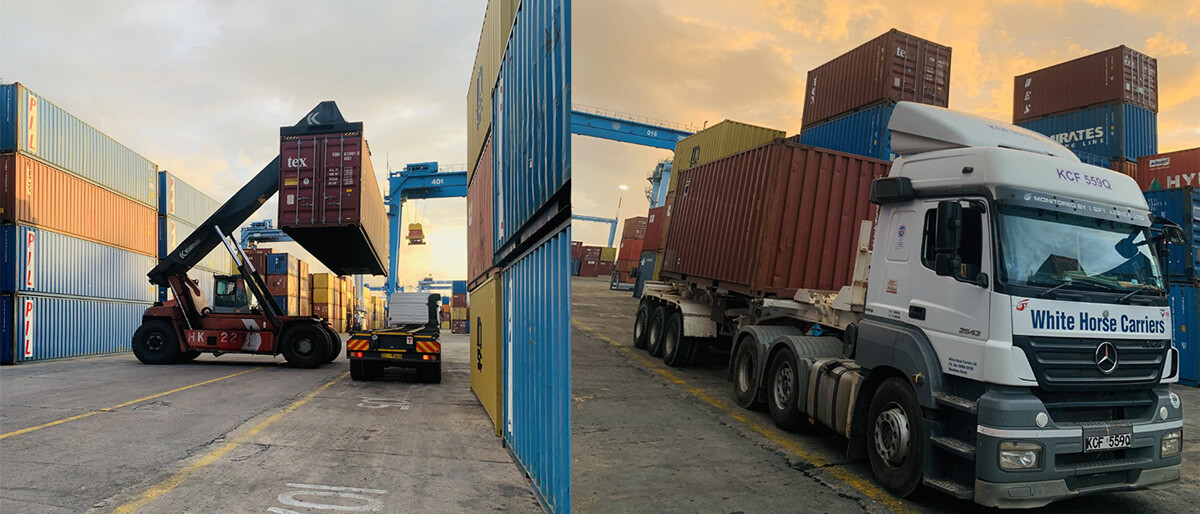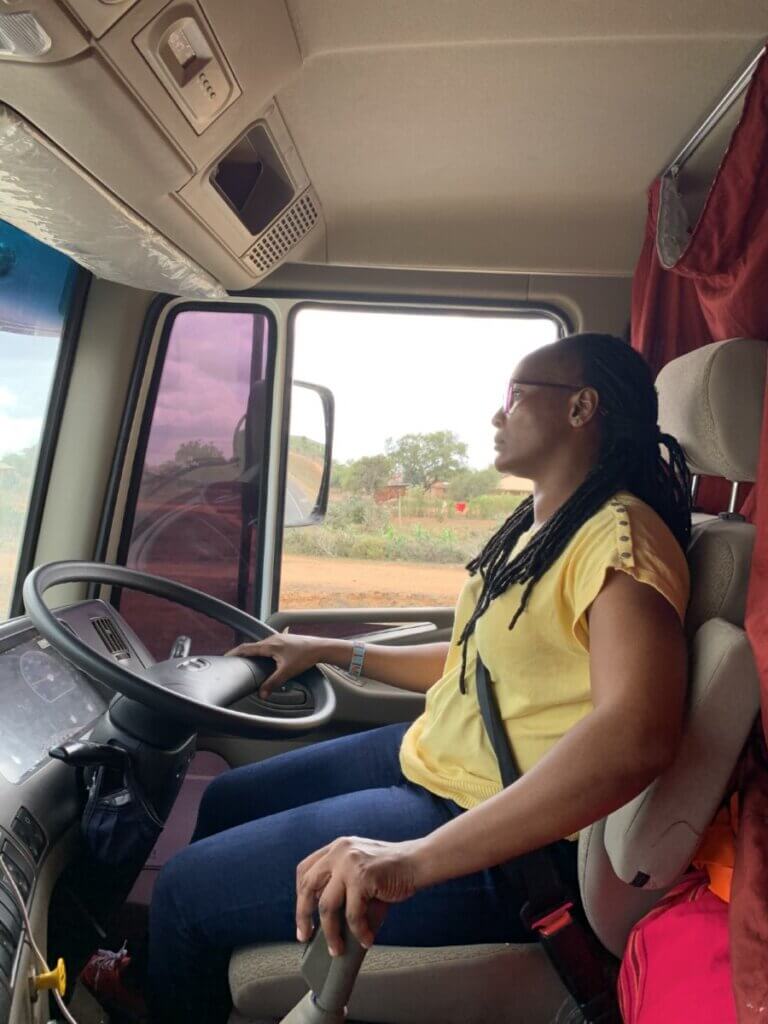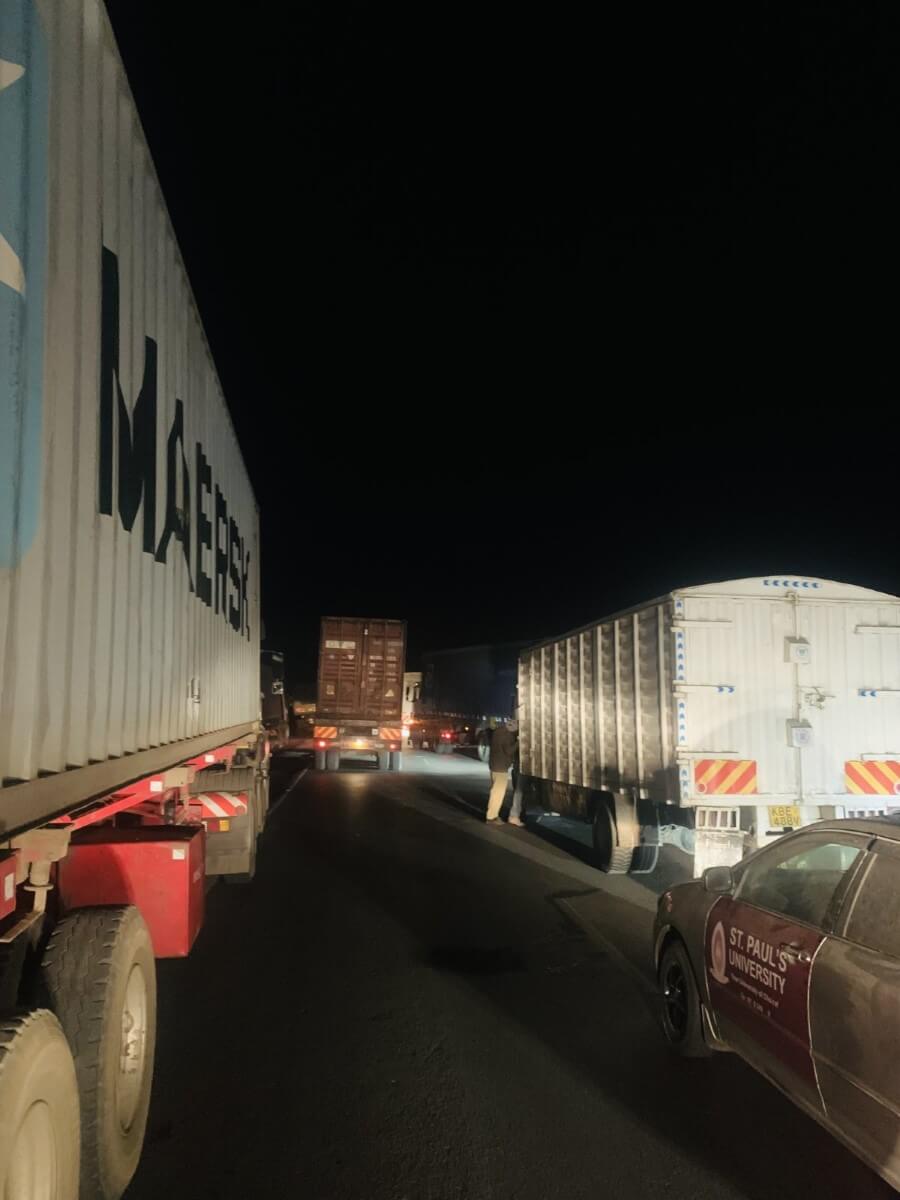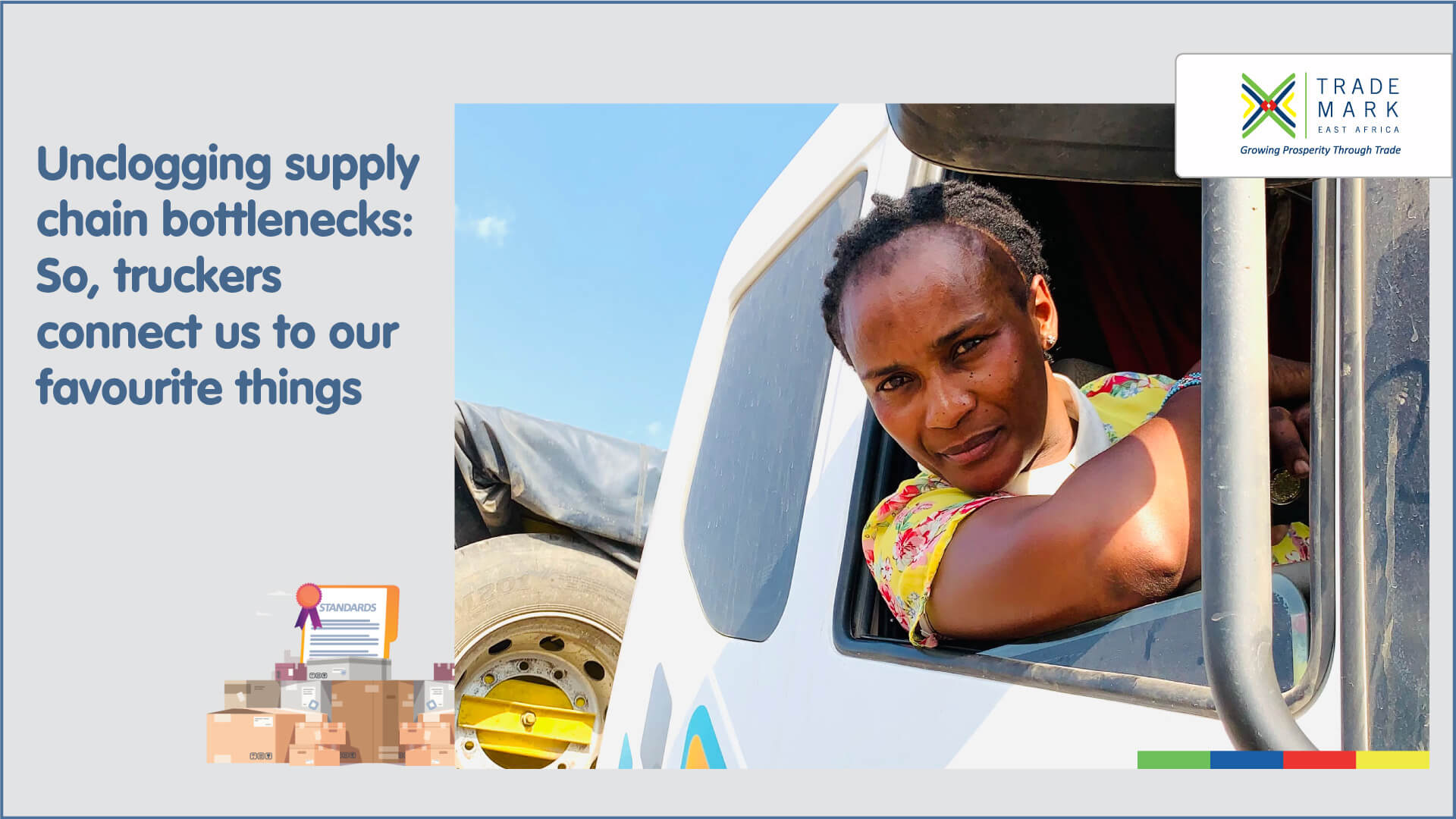The goods arrive at the port of Mombasa in big, lumbering mysterious ships. They come with impossible names like Kota Gadang, Si Hang Yun, Fox, Tramper. They come sailing under the flags of Singapore, Japan, India, Sierra Leone, Panama, China, bringing in palm oil, sorghum, kapok, coconut, sisal, cotton, vehicles, fertiliser, motorbike parts, sugar etc. They are offloaded at the berths by bigger cranes then more clearing happens as truck drivers await in their trailers in turns, shooting the breeze, watching YouTube skits from their phones as they await the call that will clear them for entry into the port for collection.
The port has changed, Jaffer Mukose – a trucker – says. He’s done nothing else since he finished high school in Uganda seventeen years ago. “When I started, everything was manual. You’d run to this office with papers to be signed, then run to another office with the same papers for another signature, then go to another and wait for hours because the signer went for a long lunch.” He chuckles. “The clearance process is much faster now with computers and automation of the processes. The different agencies seem to have reached an agreement and work more harmoniously without unnecessary delays in approvals. For some products destined to Uganda, I can find a Uganda Revenue Authority here, who will clear me such that the next stop is at the border crossing at Malaba. The roads out of the port are less congested as they have been expanded. I spend less time driving out.” He is referring to some of the gains the Mombasa Port Charter combined with technological adoption and infrastructure development have contributed to, therefore greatly improving the efficiency of maritime, inter-terminal and hinterland connectivity and increased service level at the port; ship turnaround time, berth occupancy and cargo dwell time have all improved overtime thanks to investments at the port by various development partners such as TradeMark Africa (TMA). TMA has facilitated Mombasa port improvement with an investment of approx. US$110Million over a period of 8 years.

When the call comes, he drives to the port’s entrance, producing a Port Pass that allows him entry. He then searches for his container using a Position Slip that contains information on the exact location of his cargo, and then loading ensues. Next comes a T1 slip from his clearing agent, and this slip enables him to obtain an electronic seal which prevents his luggage from being tampered with along the route. The electronic seal is the Regional Electronic Cargo Tracking System (RECTS). RECTS is crucial in avoiding dumping of goods, minimising travel delays, improving cargo security and boosting tax revenues for countries along the Northern Corridor. It was funded by the United Kingdom Agency for International Development (UKAID) and has Kenya, Uganda, Rwanda, South Sudan, DRC utilising it. Clearance lasts an hour and off he goes.
 One of the drivers driving out of the port is Faith Muiruri who works for Swan Carriers. She’s a member of Kenya Transporters Association (KTA), an umbrella body that provides a common voice for road freight industry players. She wrestles the massive trailer, turning its big head north in the direction of Tororo, Uganda where her journey will lead her. It will be a two-day journey but with the road you never know; two-day journeys have turned into one-week journeys. Things happen, sometimes the cargo truck breaks down and at other times traffic snarl-ups or other non-tariff barriers on the corridor cause delays. There are only fifty female truck drivers in the region, Faith estimates. This is a drop in the ocean in comparison to close to two million male drivers plying the Northern Corridor, a gateway and artery to an extensive economic hinterland stretching across Burundi, eastern Democratic Republic of Congo (DRC), Rwanda, Somalia, South Sudan, and Uganda. It also serves northern Tanzania and southern Ethiopia. The main cargo highway runs from the port city of Mombasa through Nairobi and Kampala to Kisangani in eastern DRC. Faith has ferried all manner of goods through this route to lands as far as Congo and Kigali, a journey that sometimes takes a week.
One of the drivers driving out of the port is Faith Muiruri who works for Swan Carriers. She’s a member of Kenya Transporters Association (KTA), an umbrella body that provides a common voice for road freight industry players. She wrestles the massive trailer, turning its big head north in the direction of Tororo, Uganda where her journey will lead her. It will be a two-day journey but with the road you never know; two-day journeys have turned into one-week journeys. Things happen, sometimes the cargo truck breaks down and at other times traffic snarl-ups or other non-tariff barriers on the corridor cause delays. There are only fifty female truck drivers in the region, Faith estimates. This is a drop in the ocean in comparison to close to two million male drivers plying the Northern Corridor, a gateway and artery to an extensive economic hinterland stretching across Burundi, eastern Democratic Republic of Congo (DRC), Rwanda, Somalia, South Sudan, and Uganda. It also serves northern Tanzania and southern Ethiopia. The main cargo highway runs from the port city of Mombasa through Nairobi and Kampala to Kisangani in eastern DRC. Faith has ferried all manner of goods through this route to lands as far as Congo and Kigali, a journey that sometimes takes a week.
The Northern Corridor accounts for over 80% of all trade of cargo in the region both interstate and international traffic outside the region. For the external trade outside the region, over 30million tonnes of goods pass through the corridor and support economic development of the region and regional and continental integration.
Gideon Chikamai of the Northern Corridor Observatory says, “The improvement in the Northern Corridor can be seen in terms of increase in volume and capacity of infrastructure, quality of infrastructure for instance international roughen index (IRI) for the roads has improved, the ease in doing business through automation of business processes, reduced transit times and reduction in delays at border points and weighbridges. Transit time from Mombasa to Kigali used to take about three weeks but now it’s less than a week. It only takes 2-3 days to move from Mombasa to Malaba Border NTBs have reduced over time.”
To witness some of the improvements Chikamai talks about, and experience what it takes to haul critical supplies from the port of Mombasa to places like Uganda, I rode in Faith’s cargo truck for three days as the turn boy. It was a journey of great solitude and sometimes unexpected peril. We started in Mombasa at dawn featuring a bruised sky over a coastal city that takes ages to stir. The urgent call of Muezzin rings out as the trailer bearing 30 tons of clinker makes its hasty exit [as hasty as a trailer can move] out of the city. In the cabin of the trailer are essentials that Faith needs for the journey; a gas stove, blankets, mattress in the bed behind, cutlery, salt, cooking fat, grains, antihistamines, painkillers, a live chicken in the toolbox (this will be turned into a meal at one point), a gallon of drinking water and a knife which could be for killing the chicken and for personal protection because the journey is long and the road is full of yahoos with ill intention. Faith recalls a time when there would be multiple stops along the transport corridor, some (or many of them) ungazetted, attacks by robbers on the highway. She contrasts that with today, where governments continuously resolve Non-Tarriff Barriers and technological innovations like Regional Electronic Cargo Tracking System (RECTS). To the naked eye, RECTS, which was funded by UKAID, is a seal attached at the back of a truck, however behind the scenes an eco-system of revenue officers sitting in command centres across the region, a rapid response team and a web of e-connectivity monitor trucks on transit and respond if the seal is broken before a truck reaches its destination. This deters theft, dumping and unnecessary stops, thus reducing time and cost related to transport.
There are check-points after every four hours of driving. Checkmate Afya Wellness Initiative [CAWi] are checkpoint centres where long distant drivers are offered health and wellness support to ensure road safety. There, Faith’s vitals are checked; blood sugar, pressure, alco-blow to determine if a driver has been drinking and general alertness. The trailer is also inspected for roadworthiness. After fifteen minutes, Faith is swinging back onto the road again. Driving a slow-moving, heavy truck is a study in tedium. Nothing happens. The landscape moves together with the trees and the clouds, and she sits there alone, in this cabin that is her home for 25 days every month. She sits alone with her thoughts, wondering if her two-year-old son will grow up not knowing her, if her marriage will weather this job, this sound absence. Unlike in Uganda, the Kenya section of the Northern Corridor hardly has any stops that allow long distance truck drivers to use bathroom and shower facilities, a safe place where they can catch their breath. “For a woman you can imagine the number of challenges this presents to me,” Faith said.
Dusk normally rushes at her windscreen like a wild bat. She finds a small safe town to sleep in. Normally a place where she’s familiar, where she is called by name. She pays a guard to look after the truck as the lights go out. Literally. Her body is a clock unto itself. She can tell the time to wake up and the time to sleep.
 There are sections of the Northern Corridor that are perilous, depending on what time of night you choose to pass them. For a woman, peril lurks in innocent places; you must be aware of situations. Faith, although hardened after 15 years of long-distance driving, knows when to push her luck and when to step back. She’s a competent driver, a keen one as well. She says it too. She says things like, “male drivers would never drive this truck down a steep hill like I do. It takes the delicacy of a woman.” Or it’s not just about driving, because anybody can drive, it’s about knowing the journey intimately.”
There are sections of the Northern Corridor that are perilous, depending on what time of night you choose to pass them. For a woman, peril lurks in innocent places; you must be aware of situations. Faith, although hardened after 15 years of long-distance driving, knows when to push her luck and when to step back. She’s a competent driver, a keen one as well. She says it too. She says things like, “male drivers would never drive this truck down a steep hill like I do. It takes the delicacy of a woman.” Or it’s not just about driving, because anybody can drive, it’s about knowing the journey intimately.”
At the border of Uganda and Kenya, there is a long queue of trucks waiting for clearance into Uganda. The border is a buzz of activity as thousands of traders and travellers move about their business. With the help of TMA and its donors the UKAID and Global Affairs Canada, the One Stop Border Post (OSBP) brought under one roof agencies representing both countries and dealing with exit procedures, so that border users stop only once in the country of destination. An integrated border management system has reduced paperwork effectively reducing transaction time and costs to exit and enter the border by up to 70 percent. As part of OSBP implementation, TMA rolled out targeted approach reaching women traders brings together border officials and women groups to resolve unique issues (such as sexual harassment) faced by women cross border traders. Further the OSBP has allocated the women with an office space where they access trade and market related information, as well as carry out lobbying efforts. Women make over 80% of informal cross border traders across East Africa. “It (the OSBP) is much better than it was before. We would be parked here for three days waiting to be cleared across the border. Now it takes about three hours. It could be more efficient than this by reducing the time further to one hour.” Says Faith.
Faith’s wishes could be achievable as TradeMark Africa continues to support the Northern Corridor efficiency, recognising it as an important transit transport route. Recently, the aid for trade organisation signed a US$1.05m finance agreement with The Northern Corridor Transit and Transport Coordination Authority (NCTTCA) to enable the agency to collect and analyse data related to transport of goods and persons. The data will support governments and development partners to design and implement evidence-based interventions that will further enhance the corridor’s efficiency.
As soon as she crosses the border, Tororo is only forty minutes away. Faith will offload the goods, sign the handover, and then find a place to sleep before getting on the road to do it all over again, only this time, in reverse. As our trip ended, I imagined, that all the things that I buy at the store, truckers bring them. Making trade efficient from the port, through the transport corridors has a bearing on life as we live it.
As written by Jackson Biko.















